Quick Start Guide
The Censys Platform offers an expansive, structured view of global internet assets built on the Censys Internet Map. It provides rich context on hosts, services, certificates, and other infrastructure. Use the Platform to query structured datasets for comprehensive internet-wide analysis, using data such as WHOIS, CPEs, CVEs, TLS hashes, and helpful labels, fully indexed for fast searching, pivoting, and correlation.
This guide provides you with the quickest route to start using the Platform to search the Censys datasets, how to understand the data, and other tools and features that enrich your experience.
Video overview
Create account
It's easy to get started with a Free account. To sign up for an account:
- Go to the account creation page.
- Enter the required information and click Create Account.
- You receive an email to verify your account. Once your account is verified select Censys Platform.
- Enter your credentials. Once you sign in, you land on the Censys Platform interface.
NoteYou can also use the Platform without registering an account or logging into an existing account. Unauthenticated users are limited to a smaller number of actions and a limited dataset.
What you can search for in the Censys Platform
Censys scans the entire public internet to find reachable IPs, services, certificates, and more. These scans discover and build structured data records such as hosts, web properties, and certificates that help you to quickly search, investigate, and connect related assets. You can see the structure of Censys datasets on the Data Definitions page in the Platform web UI.
Hosts
The Platform host dataset consists of current records of internet-facing IPv4 and IPv6 hosts. Each host is identified by an IP address and includes detailed information about exposed services, such as IP addresses, protocols, software, and ports. Use the Platform to search structured host fields such as service details, DNS names, location, and known vulnerabilities.
As a security practitioner, you could search on fields like host.services.software.product to discover hosts running a specific application, or host.services.port to identify exposed services on sensitive ports.
Web properties
Web properties are websites, APIs, and web-based apps. Web properties are identified by a hostname and a port. Hostnames can be name-based records (such as platform.censys.io) or IP-based records (such as 104.18.10.85). Search across web properties to find hostname-level detail, HTTP response data, or visibility into services running on top of HTTP for web-facing applications. Web properties provide a direct window into application behavior and communication with clients.
Search on fields such as web.endpoints.banner or web.endpoints.http.body_hash to find reused infrastructure or cloned malicious content. If you know a specific service banner associated with a known malicious service, you could search for web properties with that banner, for exampleweb.endpoints.banner: "Apache HTTP Server".
Certificates
Certificates are cryptographic files used to authenticate websites and secure communications. Search on fields such as the issuer, subject, validity period, subject alternative names, and signature algorithm to find certificates issued to specific organizations or domains.
For example, search cert.parsed.subject.organization:"Google" to identify all certificates issued to Google.
Go to the Data Definitions page in the Platform web console for a complete list of fields for all data record types.
Search the Platform dataset
Now that your account is set up, you’re ready to start exploring Platform datasets. Enter natural language input like "find host services running version 1.18.0 of nginx" in the search bar and the Query Assistant will automatically convert your request into a valid Platform query.
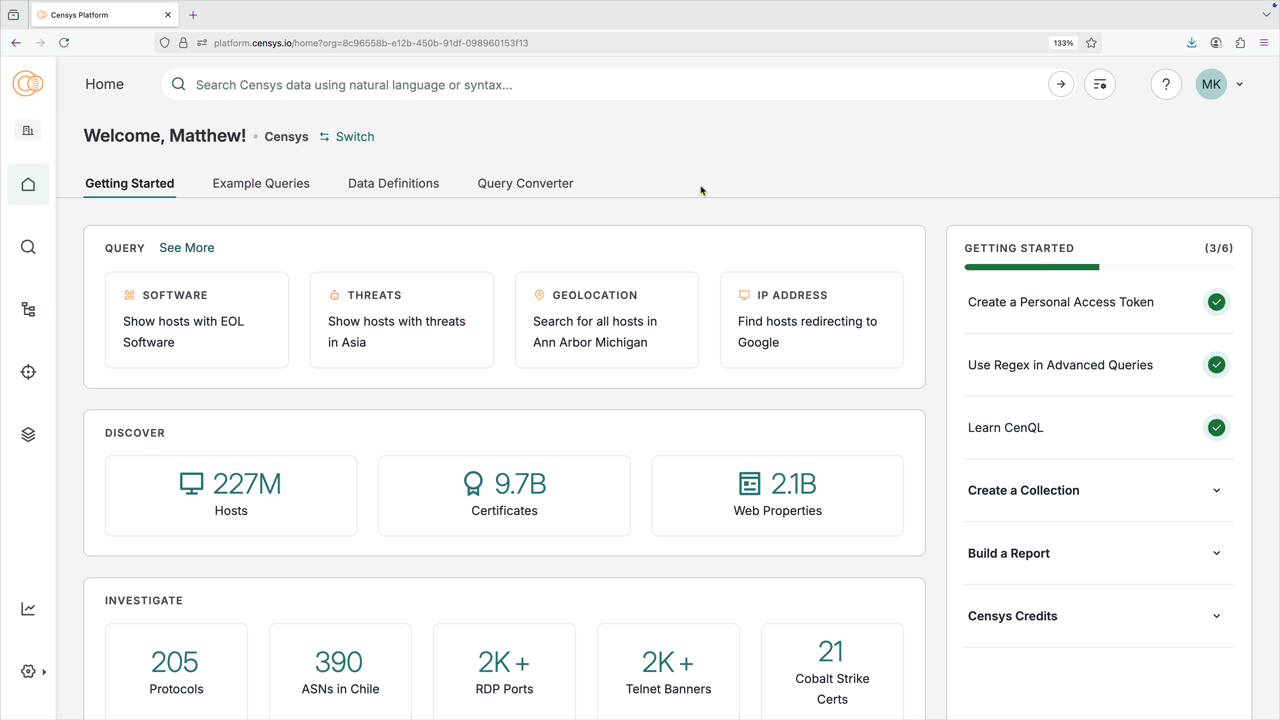
Alternatively, use the example queries below or in the web app to begin your search. You can click on the query description to run a query, or copy and paste the query syntax into the search bar at the top of the UI.
NoteThe data that you have access to in the Platform varies based on the plan you are on as well as additional modules that your organization has purchased. See Feature and Data Access Tiers for more information.
Convert Legacy Search queries
If you have queries that you used in Legacy Search, input them in the search bar. The built-in query converter will automatically turn them into valid Platform queries.
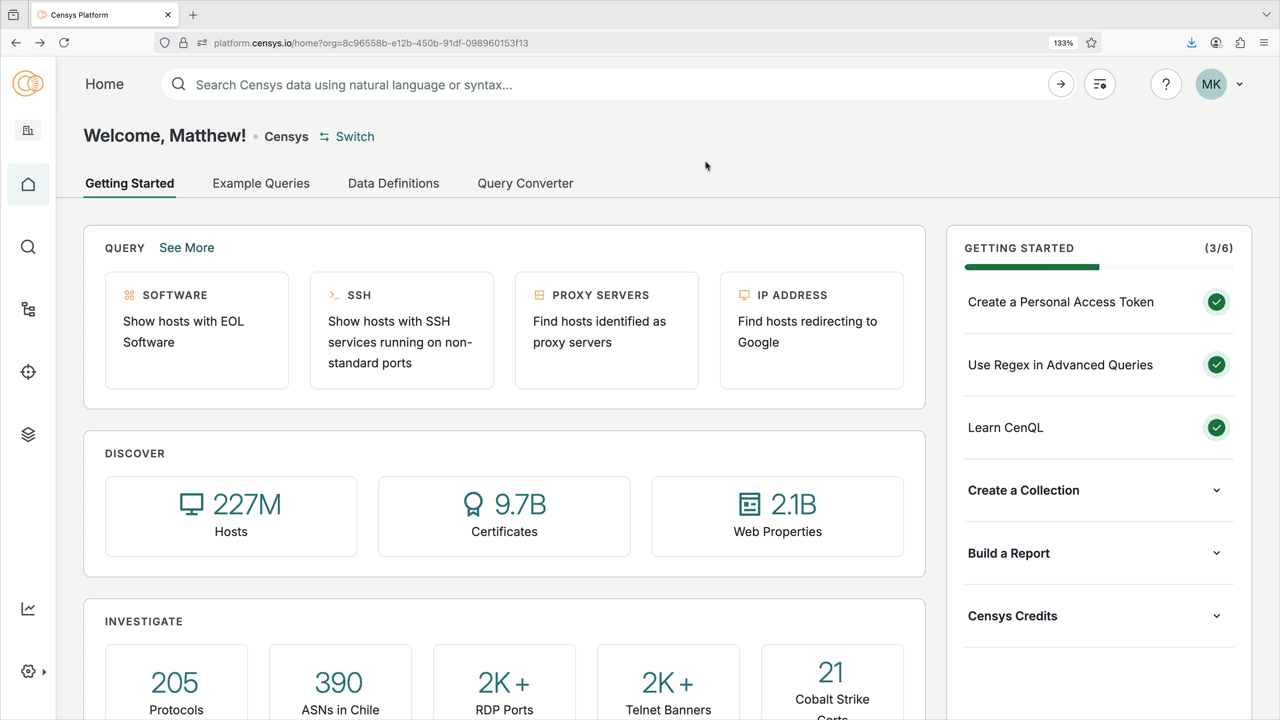
Example Platform host queries
Use the example queries below to explore common patterns in the Censys hosts dataset and familiarize yourself with the search syntax.
| Query description and link | Query syntax |
|---|---|
| Hosts with a specific service on a specific port | host.services: (port = "22" and protocol = "SSH") |
| Hosts in China | host.location.country = "China" |
| Hosts with a specific operating system | host.operating_system.product = "linux" |
| Hosts with a specific port open | host.services.port = "22" |
Example Platform certificate queries
Use the example queries below to explore common patterns in the Censys Certificates dataset and familiarize yourself with the search syntax.
| Query description and link | Query syntax |
|---|---|
| Hosts with a specific domain in their SSL certificate | host.services.cert.names = "example.com" |
| Certificates revoked in last 24 hours | cert.revocation.crl.revocation_time>="now-24h" and cert.revocation.crl.revocation_time<="now" |
Example Platform web property queries
Use the example queries below to explore common patterns in the Censys Web Properties dataset and familiarize yourself with the search syntax.
| Query description and link | Query syntax |
|---|---|
| Web properties that use port 80 | web.port="80" |
| Web properties with HTTP response codes between 200 and 204 | web.endpoints: (http.status_code >= "200" and http.status_code <= "204") |
Censys Query Language
Censys Query Language (CenQL) is the domain-specific language used in the Platform. It is designed to help you find and filter internet-facing assets. There are two primary ways to search the Censys datasets.
- A full-text search across the entire record for a value, such as "example.com." It matches any document that contains the search term in any field.
- A field query, which targets a specific field like
host.location.city = "Ann Arbor"to find matching records. This query is searching for host records where thelocation.cityfield contains the exact valueAnn Arbor.
All field names include the dataset (host, cert, or web) they are a part of. Field queries must include an operator or set of operators that define what will be considered a match for your query. Field queries typically follow the format {dataset.field} {operator} {value}. This structure can be extended with nested fields, lists, and logical operators as needed.
There are numerous operators available for search. Two key operators are : and =. The :operator performs a contains match. It returns records where the field contains the specified value. The = operator performs an exact match. It returns records where the field exactly equals the value.
You can also combine multiple conditions with AND, OR, NOT, and () to build more complex queries.
See Censys Query Language for a complete description of the CenQL syntax.
Search results
To learn how to understand Platform search results, start with a simple search like host.location.country = "China". This broad search will return all hosts in the Censys dataset that are located in China.
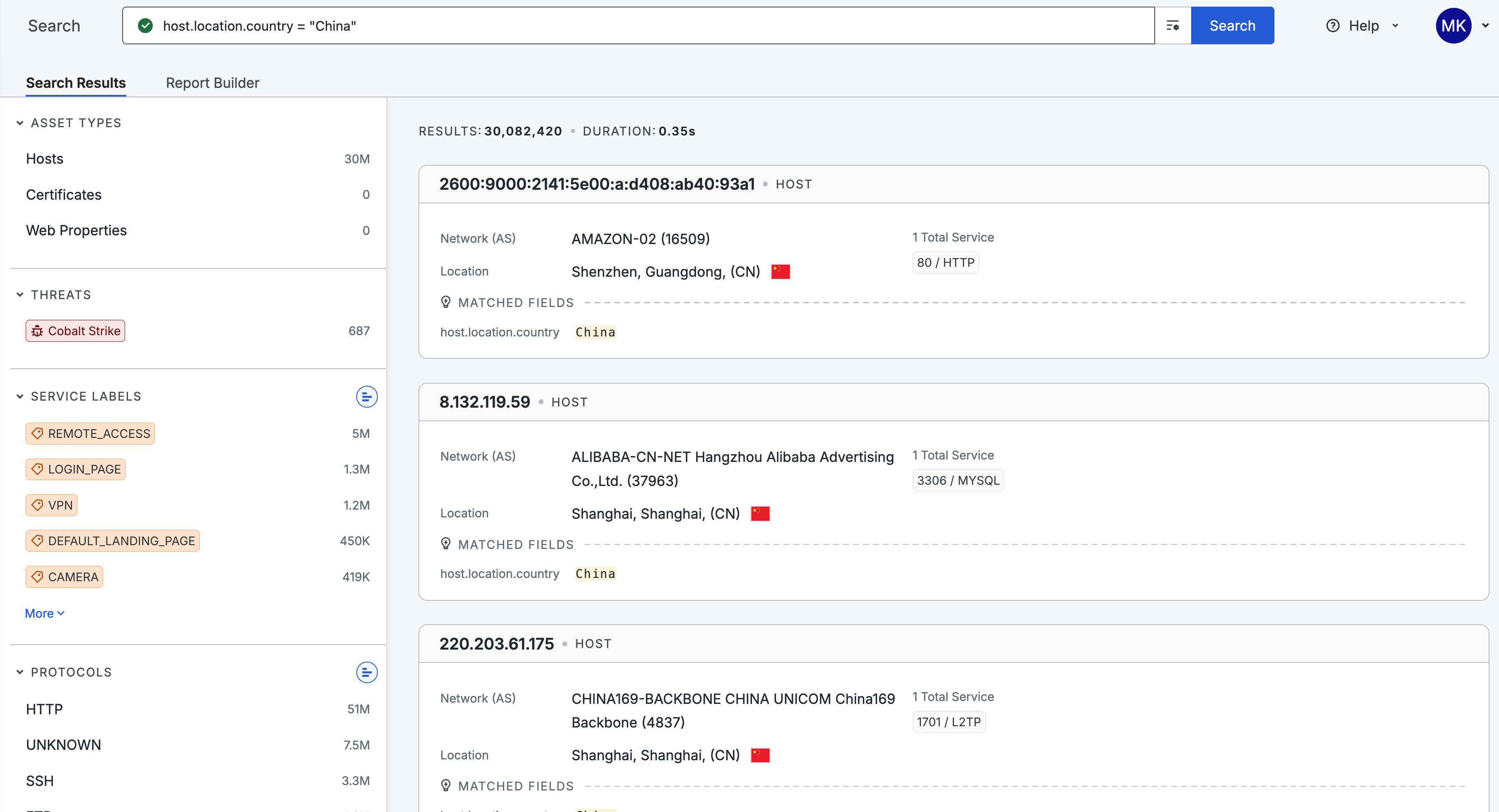
Example results for a query searching for hosts in China.
Matched fields
Data values that match your search criteria are highlighted on asset preview cards in the Matched Fields section along with their attendant fields.
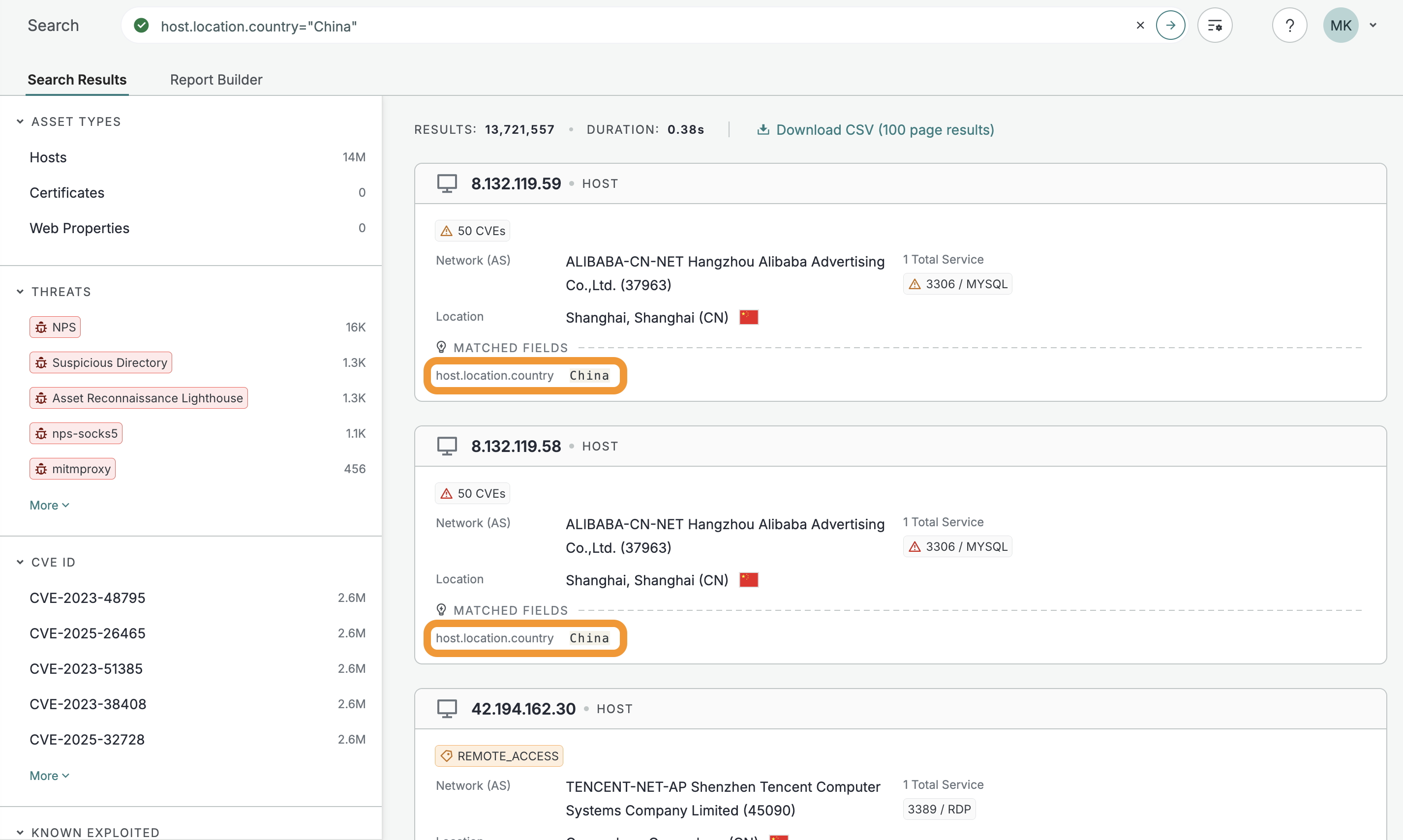
Matched fields highlighted on host preview cards in search results.
Matched services
When you search across host service data, services that include data that matches your search query are shown on the host preview card next to matched fields. Click the icon for the matched service in the preview card to navigate to the service card on the host asset.

This image shows matched services highlighted on host preview cards.
Filter results
Filter the results of your search using the options on the left side of the page. Filters vary depending on the type of asset you target with your search.
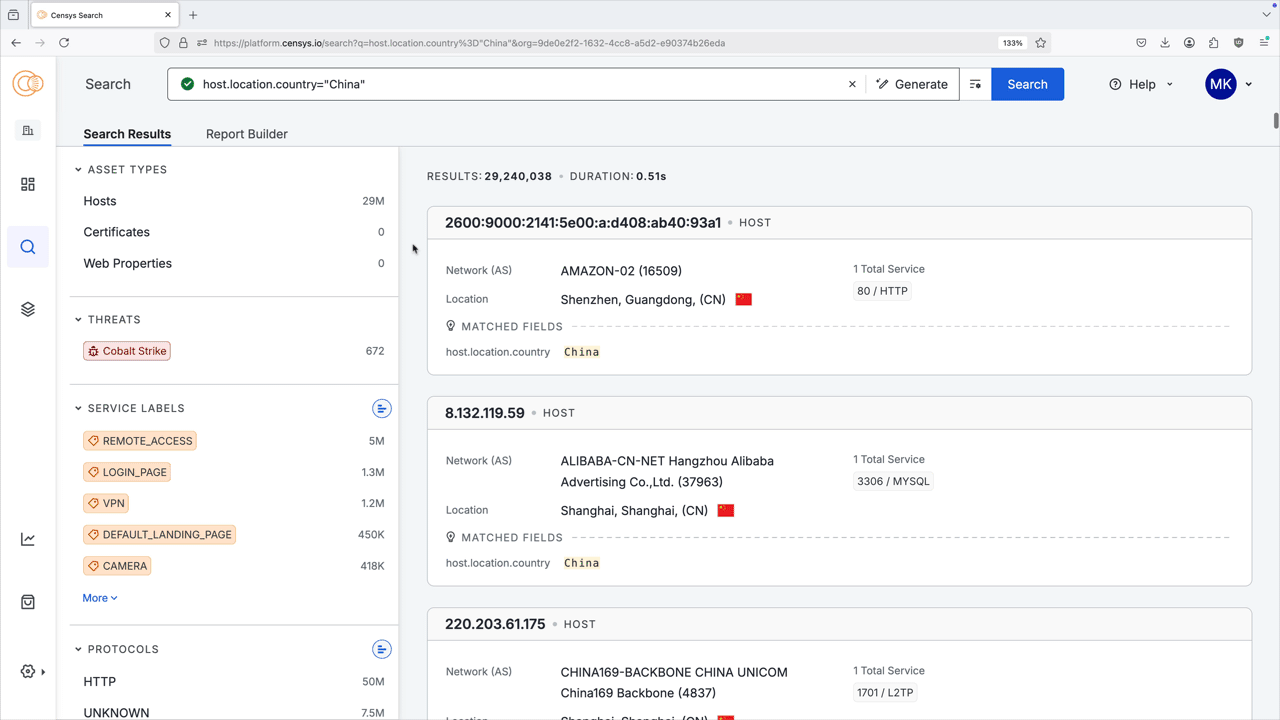
This animation shows a user adding a filter for SSH services to their initial search.
Select the aggregation button in a filter section to generate a report of your search results broken down by that field.
NoteIf your search results contain multiple asset types, then the aggregation button will not appear in the filter sidebar.

This animation shows a user creating a report for their query broken down by port.
Navigate and understand asset data
Click on an asset in the search results to see additional information about the host.
An example details page for a host record found using host.location.country="China" is shown below.

A details page for the host 222.68.8.52.
At the top, the IP address is displayed. There are 13 open ports and services on this host. The host is located in Shanghai, under China Telecom (AS4812).
Actionable data for this host includes:
- There is an exposed remote access (SSH on port 22) service. This is significant because SSH is open to the public internet and is often targeted for brute-force attacks.
- There are numerous HTTP services on high or non-standard ports. Port 3000 often indicates a development environment. 18080 is a non-standard port often used as an alternative to the standard HTTP port 80 or HTTPS port 443. Ports 9981 through 9986 are within the range of non-standard ports, often used for various applications and services.
While these ports can indicate a development environment or alternative configurations, they can also signal a security measure that obscures services from attackers relying on standard port scans.
Summarize host
NoteThis feature is available to Starter and Enterprise customers.
You can use the Censys Assistant to summarize a host you are viewing in the UI by clicking the Summarize host button in the top-right corner of the page. The assistant will produce a concise, human-readable summary of the host and services present on it.

Download search results
Users on the Core or Enterprise plans can download search results in CSV format from the Platform UI. Each page of results must be downloaded separately. CSV files contain a maximum of 100 results each.
To download search results, click the Download CSV link at the top of a results page.

Collections
Collections allow you to track and monitor the results of a Censys query over time. Collections save you time and resources as they tracks additions and removals to assets that match your queries.
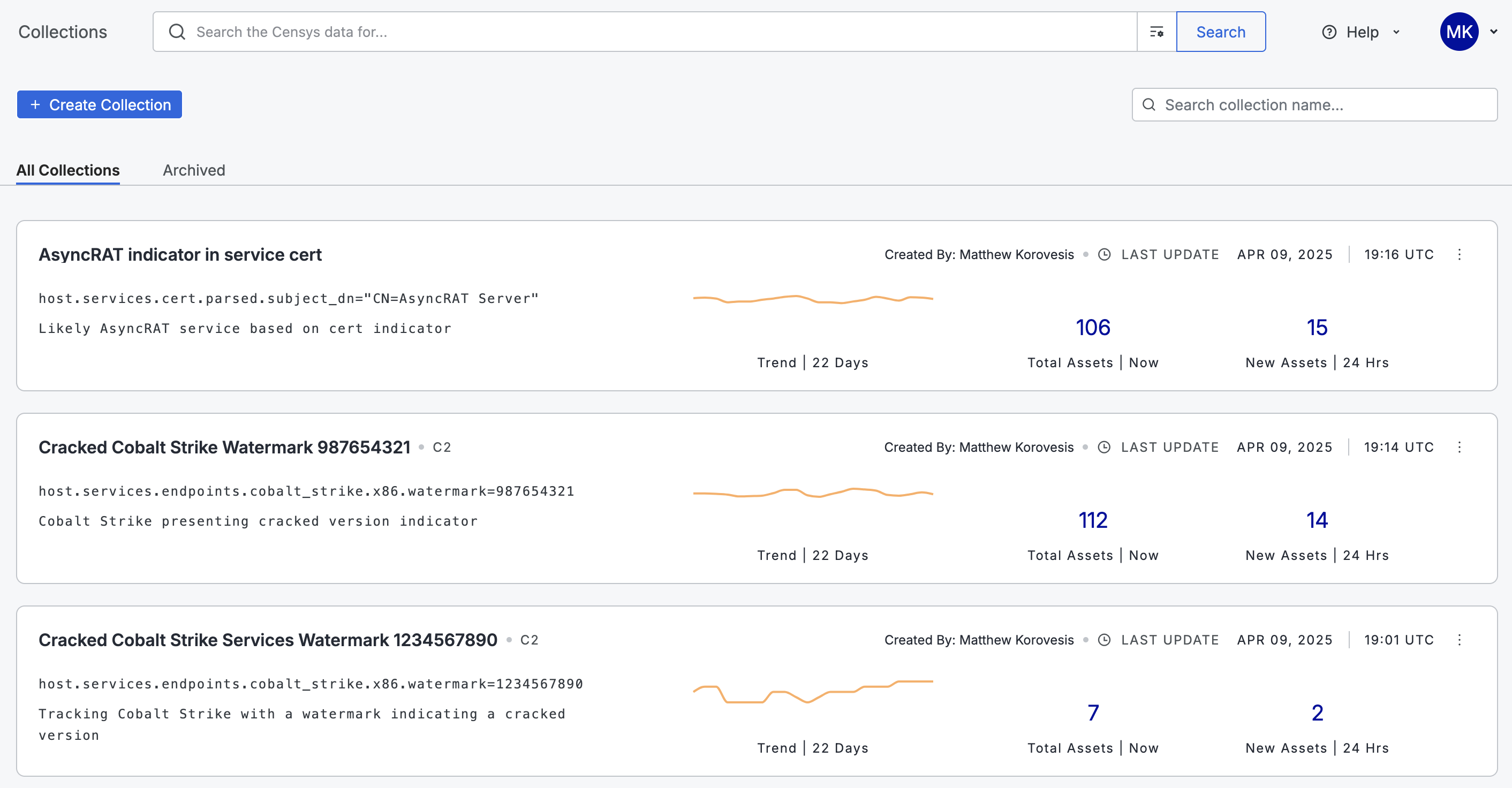
Some example collections in the Censys Platform.
Follow the steps below to quickly create a collection.
- In the left sidebar, click Collections.
- Click Create Collection and enter a Collection Name.
- Enter a valid query that defines the collection membership. A collection may only target one query. Multiple queries or search criteria can be combined using the
oroperator. - Use the Size Estimator to view the number of assets it currently returns.
- (Optional) Add a description to explain the purpose of the collection. Select a Collection Category to filter collections and displayed alerts, enhancing triage efficiency.
- Click Create.
Webhooks
Collection webhooks provide organizations with the ability to receive trigger-based updates when new assets are added to or removed from their collection. Webhooks deliver Censys data to various applications, enabling users to monitor events and take action as needed.

Three example collection alerts sent to Slack via webhook.
To configure webhooks, you need a target URL from the application that receives the webhook. Follow the instructions below to create a webhook:
- Go to Settings in the side navigation menu and click Alerts and Notifications.
- On the Alerts and Notifications page, click Create New Webhook and name it.
- Enter the target URL. This URL is where Censys sends HTTPS requests for event delivery. The target URL is provided by the web service that receives the events.
- Select one or more collections as the source of trigger events.
- In the Event Types section, select the checkbox for each collection event you want to trigger the webhook.
- In the Advanced Settings section, Select an optional payload template. The payload template defines the structure and content of the data sent to your webhook URL when a collection event occurs.
- Click Test Webhook.
Organization Switcher
The Organization Switcher allows users to switch between organizations they belong to and their Free account. Users can seamlessly access their different accounts, navigate, and interact with organization-specific data and functionality. You can use your Free tier as a sandbox environment to explore search capabilities, refine queries, test Platform features, and more, without using your paid credits. You must have a Starter or Enterprise tier account or be a member of an organization to use the Organization Switcher.
Click Switch in the upper left and select the org you want to use.
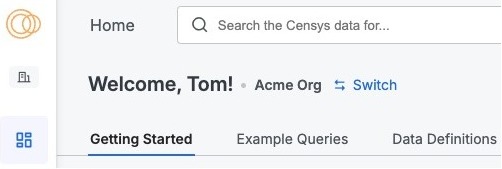
To learn more, see Organization Switcher.
Censys Platform API
The Censys Platform API offers numerous endpoints for Global Data, Threat Hunting, Account Management, and Collections. The quickest way to make an API call is on the API reference documentation using the Try It feature.

You need a Personal Access Token (PAT) to use the Platform API. Some Platform API endpoints (like asset lookup endpoints) can be used by Free users. Other endpoints are only available to users on the Starter or Enterprise tiers. Learn more in the API documentation.
Legacy Search users
Users transitioning from Legacy Search to the Censys Platform are encouraged to review the transition guides. These guides are designed to streamline the process and accelerate time to value.
- Transition Guides for Free Users, Solo, and Teams Subscribers
- Censys Platform Syntax Differences
- Dataset Differences: Censys Platform vs. Legacy Search
Query Converter
The Query Converter is designed to help users transition the queries they used in Legacy Search to the Platform. Enter a Legacy Search query into the Query Converter to identify syntax differences and view recommended changes to correct your query.
To learn more, see the Query Converter documentation.
Updated 18 days ago
